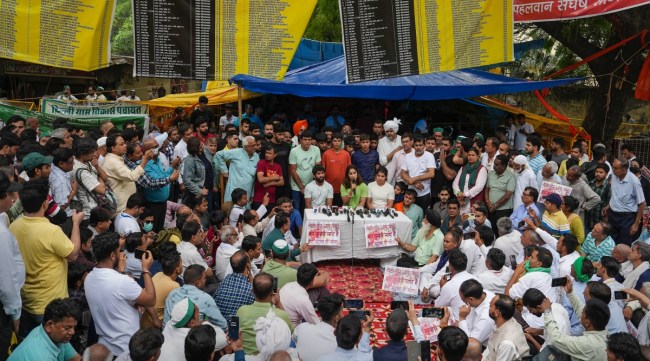Opinion Wrestlers’ protest shines a light on toxicity of guru-shishya relations
The teacher-disciple relation in Indian sports is inextricable with patriarchy, misogyny and casteism
 In this pictures, wrestlers Bajrang Punia, Vinesh Phogat and Sakshi Malik speaks with the media during their protest at Jantar Mantar, in New Delhi. (PTI Photo)
In this pictures, wrestlers Bajrang Punia, Vinesh Phogat and Sakshi Malik speaks with the media during their protest at Jantar Mantar, in New Delhi. (PTI Photo) In the bylanes of counterfactual history, Guru Dronacharya accepted Eklavya as his shishya (disciple) and permitted him to stay in his ashram. When later reminded about his commitment to make Arjuna the best archer, the Guru asked Eklavya to cut off his right thumb and give it as a gurudakshina. Eklavya succumbed to Dronacharya’s demand. This story remained the ashram’s secret.
In the real world, a similar thing occurred with India’s women wrestlers. However, the guru-shishya relationship reached a new low with allegations of sexual harassment against the former.
The Indian sports culture is anchored in the guru-shishya tradition. That is the root cause of most of the issues that have come to light after the protests by wrestlers. Gurus are the central figure of sports culture in India. In popular belief, they carry powers of creation and destruction. However successful, athletes are never equal to the guru who appear in different avatars — elders, trainers, or federation officials. The emancipation – or subjugation – of the disciples depends a lot on the blessings of these gurus and less on their performance in the sports field.
The guru-shishya tradition also comes with the toxicity of patron-client relationships and is inextricable from patriarchy, misogyny and casteism.
More than other sports, wrestling is traditionally a rural game and moored in the ashram culture. Aspiring wrestlers leave their homes and join various akharas at a certain age to represent their states and country and, in return, to get a job and earn a livelihood. However, the guru-shishya culture does not remain at the akhara-level but pervades into the larger sports culture in India.
 Congress leader Devender Yadav with wrestler Bajrang Punia and others during the wrestlers’ protest at Jantar Mantar, in New Delhi. (PTI Photo)
Congress leader Devender Yadav with wrestler Bajrang Punia and others during the wrestlers’ protest at Jantar Mantar, in New Delhi. (PTI Photo)
Women’s wrestling did not start smoothly in India. The wrestling fraternity did not accept women in the sport, which was considered a male domain until the 2000s. While the history of women’s wrestling can be traced back to 330 BC in the Etruscan civilisation in ancient Italy, it was in 1987 that women’s wrestling had a world championship. In 2004, it was introduced at the Athens Olympics, much later than the male wrestling competitions were introduced.
Initially, there was almost no taker for women’s wrestling in India. No wrestling competition was open for women wrestlers, and they had to put up with “exhibition” matches outside the main dangals. Later, they were allowed to grapple with male wrestlers. There were threats, boycotts, and violence against women wrestlers. Almost all the big gurus, except a few, hesitated to give space to women in Indian wrestling. Their late entry into the wrestling world did not deter women athletes from winning medals at international competitions. Alka Tomar won a bronze medal at the World Championship in 2006. Their performance at the world level opened spaces and warmed the wrestling fraternity in India to women’s wrestling.
All the protesting wrestlers are athletes of international repute and have a promising future. They should have been in the practice camps preparing for the Paris Olympics of 2024. Instead, they have been forced to protest the head of the Wrestling Federation of India (WFI), Brij Bhushan Singh. This is not the first time that officials of sports federations have been accused of sexual harassment charges. Recently Haryana Sports Minister Sandeep Singh faced similar allegations.
Usually, the athletes do not dare to complain, fearing harm to their career prospects. The powerful people in the sports bodies can end an athlete’s career.
We often see athletes as just the flag bearers of the nation. But they are also embedded in the nation’s social, cultural and political life and have a social identity.
In the early 20th century, British officials used arbitrary logic to classify some castes as martial groups and gave them exclusive rights over land. Many wrestlers, irrespective of gender, belong to these groups. Wrestlers from backward castes are pushed to the margins if they dare to enter.
 Bharatiya Kisan Union (BKU) leader Rakesh Tikait with wrestlers Bajrang Punia, Vinesh Phogat and Sangita Phogat during the wrestlers’ protest. (PTI Photo)
Bharatiya Kisan Union (BKU) leader Rakesh Tikait with wrestlers Bajrang Punia, Vinesh Phogat and Sangita Phogat during the wrestlers’ protest. (PTI Photo)
Casteism is inimical to sports culture. Wrestling must be unclutched from the guru-shishya tradition. Unfortunately, the present protest is not challenging this relationship. Instead, it’s asserting the benevolent aspect of the tradition. The wrestlers have asked for the support, guidance, and blessings of their khap panchayat elders. This goes against the politics of gender justice. The khap panchayats’ view on women’s liberation and caste justice is well-known.
ie_content_priority_driven exkeyword=”Must, Read, Opinions” link=”https://indianexpress.com/section/opinion/” hlabel=”Must Read Opinions” hlink=”https://indianexpress.com/section/opinion/” pid=”1929664″ mlabel=”Click here for more” mlink=”https://indianexpress.com/section/opinion/”
This protest has shown the strength and courage of women wrestlers. However, its potential to liberate will be limited if it persists with the language of traditions.
The writer, a former wrestler, is an Assistant Professor of History at the University of Delhi.






